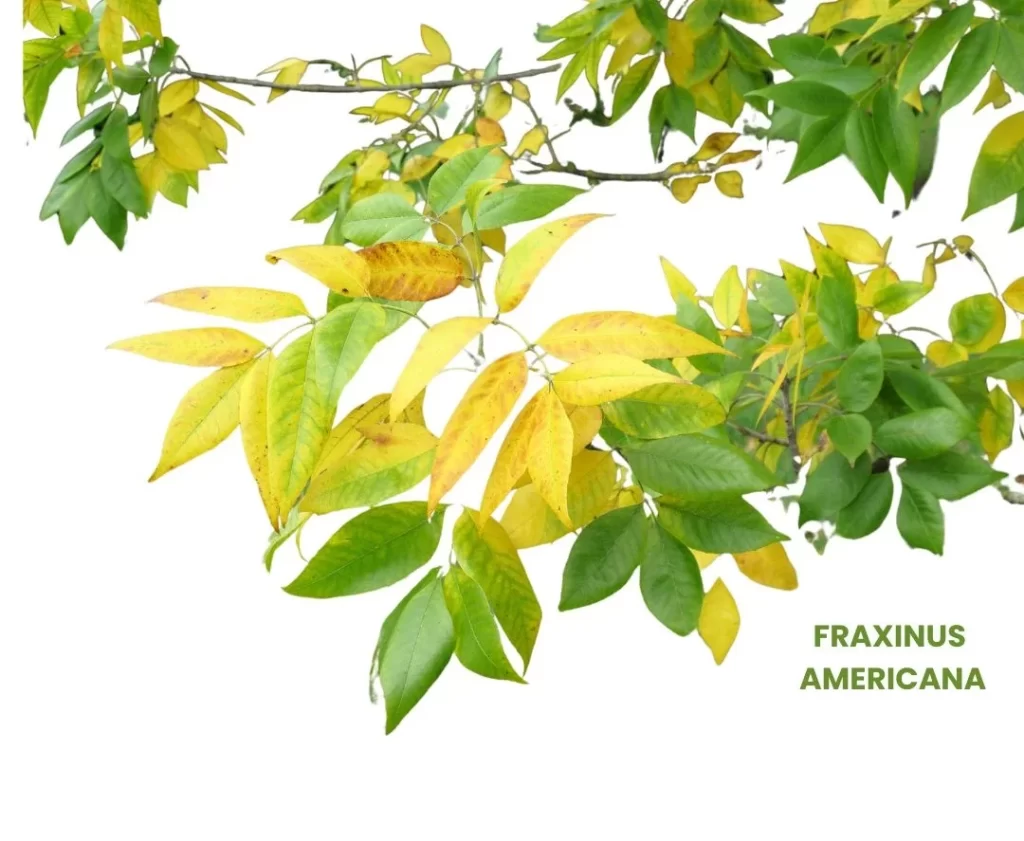Fraxinus Americana, commonly known as White Ash, is a homeopathic remedy recognized for its efficacy in addressing various female reproductive issues, particularly those involving the uterus.
It is also known for its effectiveness in treating conditions such as infantile eczema and cramps in the feet.
This remedy is derived from the White Ash tree, a species native to North America.

Table of Contents
ToggleSOURCE INFORMATION
Scientific Classification
- Kingdom: Plantae
- Order: Lamiales
- Family: Oleaceae
- Genus: Fraxinus
- Species: Fraxinus americana
Origin
- White Ash is indigenous to eastern and central North America.
- It thrives in rich, moist soils and is commonly found in forests and woodlands.
Historical Facts
- Traditionally, Native American tribes used the bark and leaves of the White Ash tree for medicinal purposes, including treating fevers, inflammation, and other ailments.
- In homeopathy, its focus has been on conditions related to the female reproductive system and certain skin conditions.
DRUG PATHOGENESIS
Fraxinus Americana affects the female reproductive organs, leading to symptoms such as uterine enlargement, fibrous growths, and bearing-down sensations.
It also impacts the nervous system, causing restlessness and anxiety, and the skin, where it can help with conditions like infantile eczema.
KEY CHARACTERISTICS
- Uterine issues: Enlargement, fibroids, subinvolution, and prolapse with bearing-down sensations.
- Skin conditions: Fever sores on lips, infantile eczema.
- General symptoms: Cramps in feet, cold creeping, and hot flashes.
DETAILED ORGAN SYMPTOMS
HEAD
- Throbbing pain: Particularly in the back of the head.
- Depression and anxiety: Accompanied by nervous restlessness.
- Hot spot: A sensation of heat at the top of the head.
FEMALE REPRODUCTIVE SYSTEM
- Uterus: Enlarged and patulous (expanded and open).
- Leucorrhoea: Watery and non-irritating vaginal discharge.
- Fibroids: Presence of uterine fibroids causing a bearing-down sensation and cramping in the feet, worse in the afternoon and at night.
- Dysmenorrhea: Painful menstruation.
- Abdominal pain: Tenderness in the left inguinal region with pain extending down the thigh.
SKIN
- Fever sores: Sores appearing on the lips.
- Infantile eczema: Skin condition in infants.
EXTREMITIES
- Cramps: Cramps in the feet, often occurring in the evening or at night.
MODALITIES
- Aggravations: Symptoms are generally worse in the afternoon and at night.
- Ameliorations: Relief is often achieved through proper rest and appropriate homeopathic treatment.
WHAT ARE MODALITIES IN HOMOEOPATHY?
RELATIONSHIP WITH OTHER DRUGS
Compare with:
FRAXINUS EXCELSIOR (EUROPEAN ASH)
- Conditions Treated: Gout, rheumatism.
- Historical Use: Infusion of ash-leaves was used by Dr. Rademacher, a well-known 19th-century physician, to treat these conditions.
- Mechanism: The leaves of Fraxinus excelsior contain anti-inflammatory compounds which help in reducing pain and inflammation associated with gout and rheumatism.
GALEGA (GOAT’S RUE)
- Conditions Treated: Backache, debility, anemia, and impaired nutrition.
- Mechanism:
- Milk Production: Increases both the quantity and quality of breast milk in nursing women, which is especially beneficial for those experiencing low milk supply.
- Appetite Stimulation: Helps in improving appetite, thus aiding in better nutrition and overall health.
- Additional Benefits: Useful in managing symptoms related to fatigue and weakness due to its tonic properties.
EPIPHEGUS
- Conditions Treated: Known for addressing headaches, particularly those associated with mental exertion and stress.
- Mechanism: Acts on the nervous system to alleviate headaches and related symptoms.
SEPIA
- Conditions Treated: Female reproductive issues such as pelvic organ prolapse, dysmenorrhea, and leucorrhoea.
- Mechanism: Balances hormonal levels and addresses emotional symptoms associated with reproductive health, such as irritability and depression.
LILIUM TIGRINUM (TIGER LILY)
- Conditions Treated: Uterine and ovarian conditions, including prolapse and menstrual irregularities.
- Mechanism: Acts on the female reproductive organs, helping to restore normal function and alleviate symptoms like pelvic congestion and bearing-down sensations.
DOSE
Typically administered in doses of ten to fifteen drops of tincture, three times a day.
Frequently Asked Questions
What conditions does Fraxinus Americana treat?
- It is primarily used for treating female reproductive issues such as uterine enlargement, fibroids, and prolapse, as well as skin conditions like infantile eczema and fever sores.
How should Fraxinus Americana be dosed?
- The recommended dose is ten to fifteen drops of tincture taken three times a day.
Meaning of Difficult Words
- Subinvolution: Failure of an organ to return to its normal size after enlargement, typically referring to the uterus after childbirth.
- Prolapse: A condition where an organ falls or slips out of its normal position.
- Dysmenorrhea: Painful menstruation.
- Leucorrhoea: A white or yellowish discharge from the vagina.
- Patulous: Expanded and open.
- Inguinal region: The area of the lower abdomen just above the thigh.
This detailed drug picture of Fraxinus Americana provides an in-depth understanding of its homeopathic uses, including its origin, historical context, specific symptoms across different organ systems, and practical application in homeopathy.
